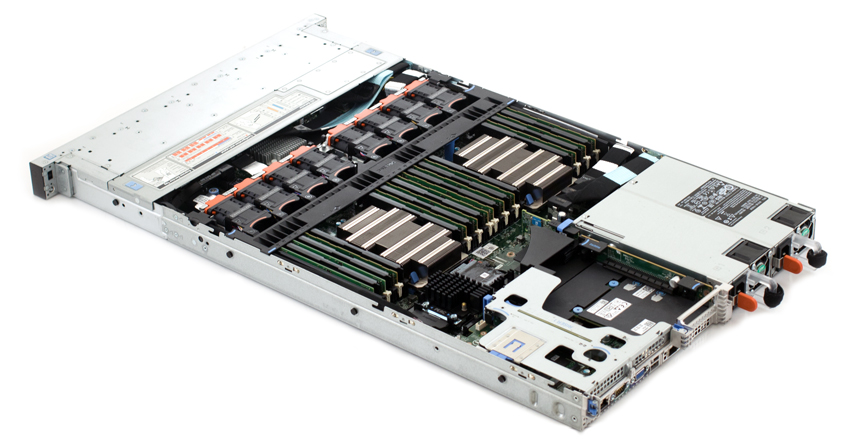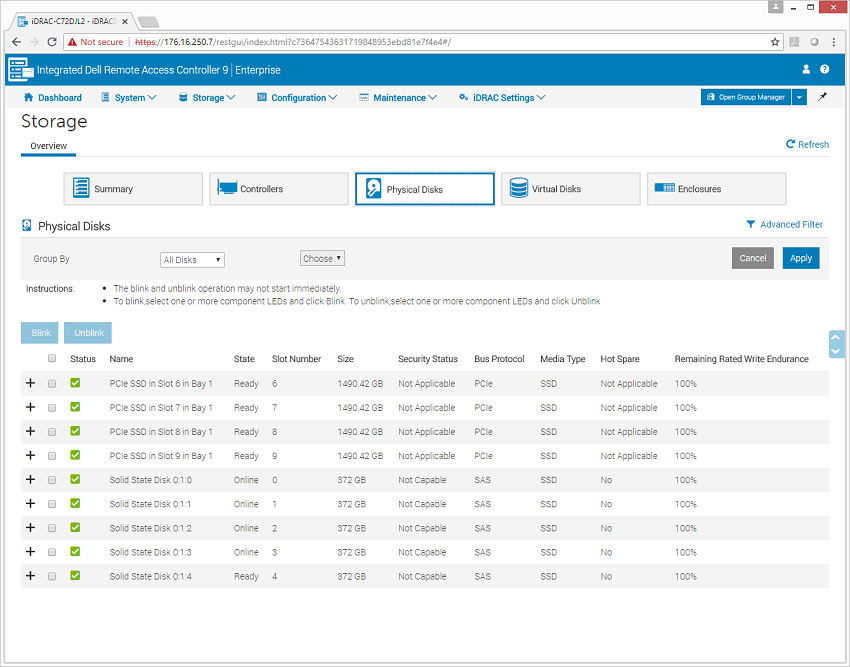The PowerEdge R640 is a scalable 1U rack server designed for computing and storage via a 2-socket platform. Described as a balance between performance, cost and density, the R640 is built to handle workloads from a range of different data center use cases–particularly dense software-defined storage, service providers, application tier, dense private cloud, virtualization and High Performance Computing (HPC). Moreover, Dell has built the PowerEdge R640 as an easily deployable server and that can seamlessly scale from 3 to 1000+ nodes for software-defined storage using Dell EMC VxFlex Ready Nodes.

The PowerEdge R640 packs a lot of fairly powerful components, as well as a ton of expansion opportunities. For example, it can be equipped with two Intel Xeon Processor Scalable Family processors with up to 28 cores per processor. It features 24 DIMM slots for a maximum of 3TB of RAM and up to 12 NVDIMM for a maximum of 192GB of RAM. It also has two AC (or DC) redundant power supply units. The R640 also supports PCI generation-3 expansion cards.
The Dell rack server can be outfitted with 2.5” or 3.5” HDDs and SSDs and supports up to 8 NVMe for those looking for the fastest storage performance possible. This is double the amount of NVMe of the R630, so it certainly makes this 1U platform significantly more versatile. To this end, the R640 can be configured with 8 x 2.5 inch hard drives or 4 x 3.5 inch hard drives on the front panel, or 10 x 2.5 inch hard drives on the front panel with optional support for 2 X 2.5 inch hard drives on the back panel.
The PowerEdge R640 supports USB ports, NIC ports, VGA ports, serial connector, and an IDSDM/vFlash card that supports an optional flash memory card and one internal dual SD module.
For testing, we configured the R640 with Dual Intel Xeon Platinum 8180 processors and 384GB (32GB x 12) 2666MT/s RAM. Storage metrics were attained using 3.2TB of NVME (2 x 1.6TB PM1725a NVMe SSDs) and 2TB of SAS (5 x 400GB PM1635a SAS SSDs).
Dell EMC PowerEdge R640 Specifications
| Form factor | 1U |
| Processor | Up to two Intel Xeon Scalable processors, up to 28 cores per processor |
| Memory | 24 DDR4 DIMM slots, Supports RDIMM /LRDIMM, speeds up to 2666MT/s, 3TB max |
| Up to 12 NVDIMM, 192 GB Max | |
| Supports registered ECC DDR4 DIMMs only | |
| Storage Controllers | |
| Internal controllers | PERC H330, H730p, H740p, Software RAID (SWRAID) S140 |
| Boot Optimized Storage Subsystem | HWRAID 2 x M.2 SSDs 120GB, 240 GB |
| External PERC (RAID) | H840 |
| 12Gbps SAS HBAs (non-RAID) | External- 12Gbps SAS HBA (non-RAID), Internal- HBA330 (non-RAID) |
| Drive bays | |
| Front drive bays | Up to 10 x 2.5” SAS/SATA (HDD/SSD) with up to 8 NVMe SSD max 58TB or up to 4 x 3.5” SAS/SATA HDD max 48TB |
| Rear drive bays | Up to 2 x 2.5” SAS/SATA (HDD/SSD), NVMe SSD max 12TB |
| Optional | DVD-ROM, DVD+RW |
| I/O & Ports | |
| Network daughter card options | 4 x 1GE or 2 x 10GE + 2 x 1GE or 4 x 10GE or 2 x 25GE |
| Front ports | Video, 1 x USB 2.0, available USB 3.0, dedicated IDRAC Direct USB |
| Rear ports | Video, serial, 2 x USB 3.0, dedicated iDRAC network port |
| Video card | VGA, NVIDIA NVS310 available as PCIe card Up to 3 x Gen3 slots, all x16 |
| Power supplies | Titanium 750W, Platinum 495W, 750W, 1100W, and 1600W |
| 48VDC 1100W, 380HVDC 1100W, 240HVDC 750W Hot plug power supplies with full redundancy option | |
| Supported OS | Canonical |
| Ubuntu LTS | |
| Citrix XenServer | |
| Microsoft Windows Server with Hyper-V | |
| Red Hat Enterprise Linux | |
| SUSE Linux Enterprise Server | |
| VMware ESXi | |
Design and Build
Though the Dell PowerEdge R640 rack server uses a very compact build, it still boasts a ton of versatility as well as different configurations and expansion options. Like we mentioned above, this includes an 8 x 2.5-inch drive system, a 4 x 3.5-inch drive system, and a 10 x 2.5 inch drive system as far as storage goes.

The control panel is located on the left of the front side, which is home to the system health and system ID, status LED, and the iDRAC Quick Sync 2 (wireless) indicator. The Status LED displays any failed hardware components, while the optional wireless Quick Sync 2 indicates a Quick Sync enabled system (a feature that allows administrators to manage the system via mobile devices).

As is the case with all rack servers, the majority of the front panel real estate is taken up by the drive bays. In our 10-drive setup, this translates to either up to ten 2.5 inch hot-swappable drives (though users have the option to use six 2.5 hot-swappable drives), or up to four NVMe devices.
Management
As with other PowerEdge Servers, the R640 offers a wide range of management options. For a more in-depth look, readers can check out our deep dive in the Dell EMC PowerEdge R740xd review and our look into Dell EMC’s OpenManage Mobile app.

Performance
In our section looking at local-system performance, we have a well-equipped R640 which we are testing with two different tiers of flash storage. The first is NVMe flash, provided across four 1.6TB SSDs and the second is SAS flash which is provided across four 400GB SSDs. Both are Samsung branded, although specific parts may vary depending on which components are selected when the server is built. With the Intel Platinum 8180 CPUs inside, we had plenty of CPU cycles to throw at our storage workloads. As stated in our introduction section, the server came equipped with dual Intel 8180 Platinum CPUs as well as 384GB of RAM. For our application benchmarks we leverage ESXi 6.5.


Leave a Reply